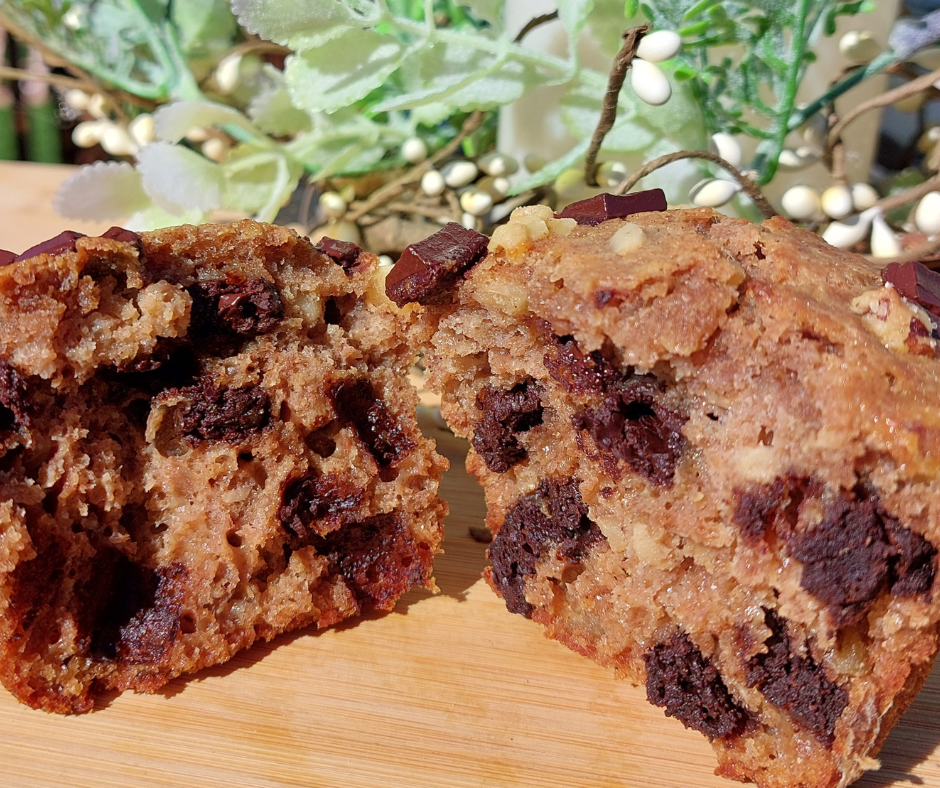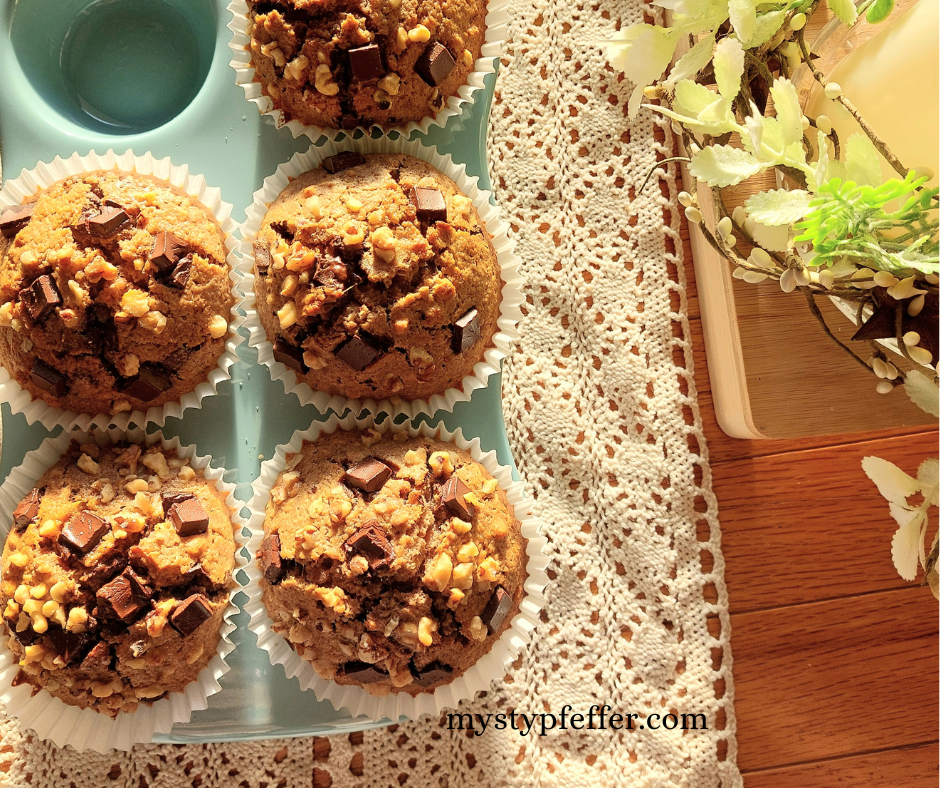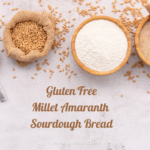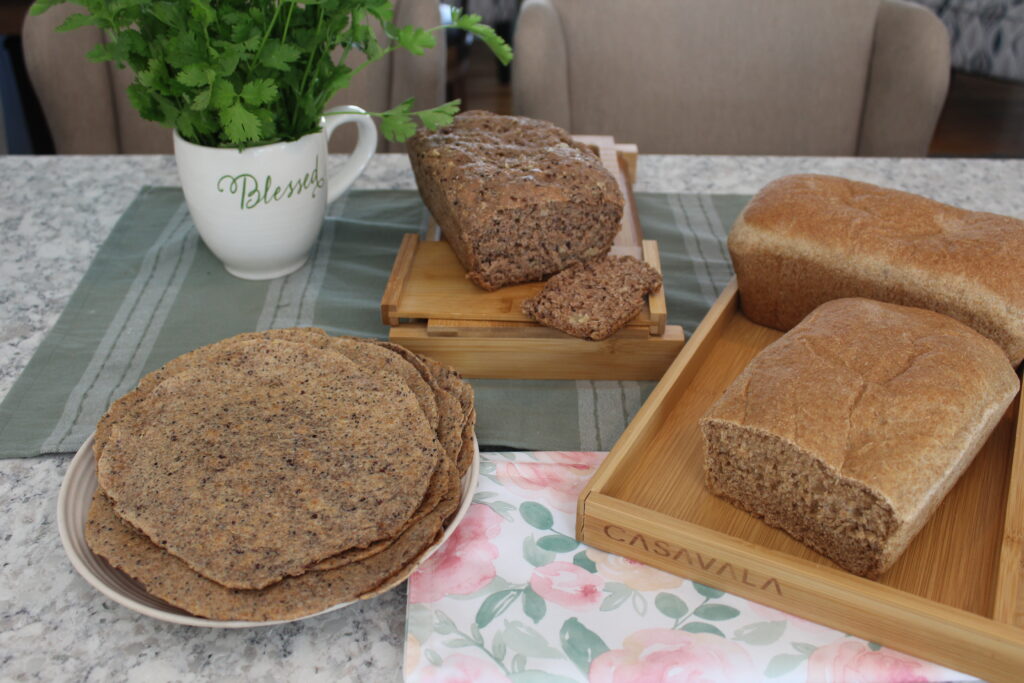Sourdough Spelt & Hard Red Chocolate Walnut Muffins
A rough week of allergies calls for some healthy comfort food! Yep! Sourdough, spelt & hard red wheat muffins with chocolate and walnuts are healthy! They are also very comforting!
I’m curious what creations you make with your sourdough starters, too! With curious bakers like you and me around, the possibilities are endless.
All I did to make these extra-large muffins was use my Peanut Chocolate Chip Muffin recipe and adapt it to include the sourdough starter. It was a total guess as to what to do here and there, so don’t be disappointed if it’s not foolproof. I am, what you might call, an experimental baker not an expert.
But boy! Do they taste good!
The next time I make these, I might change the water to half water and half nutmilk or coconut milk, but really, water worked well. The house smelled like fresh doughnuts and the moisture of the muffins was spot on.

Benefits of Sourdough Spelt & Hard Red Chocolate Walnut Muffins
I used a cup of organic fresh-milled hard red wheat and a cup of organic spelt for this recipe. I like the nutty flavor of the hard red wheat, plus it has 136mcg of selenium per cup. That’s ten times more selenium than other grains! It also packs 10.5 mg niacin, 73mcg of folate, 1152 mg omega 6, 51.8mg of omega 3, and 23.4grams of fiber!
Partnered with spelt, which is loaded with 113mg omega 3, 6.3mcg of vitamin K, 11.9mg of niacin, 7.7 mg of iron, 68.9mcg of folate, and we are talking about a decadent treat without the guilt! We’ll enjoy a combined duo of over 400mg magnesium, and 1500mg potassium with modest amounts (12mg) of zinc per cup!
I love what God puts in the garden for our good and his glory! There is no better way to overcome seasonal allergies! After all his testimony is true and faithful in the things that he made. . .
Yet he has not left himself without testimony: He has shown kindness by giving you rain from heaven and crops in their seasons; he provides you with plenty of food and fills your hearts with joy.
Acts 14:16-18 NIV – In the past, he let all nations go – Bible Gateway
Do you know him today? Is there an emptiness in your life you cannot describe? Perhaps the sense of missing a vital piece of joy and contentment is something you can’t quite shake. Spiritual health as well as physical health is withing reach! Knowing Jesus as Lord and Savior fills that mysterious and unnamable void and can be yours today!
I will pray it consumes you, in a good way, as you seek him in his word!
You won’t regret surrendering your life to him, I promise you. In the meantime, check out the recipe for these delicious muffins to tantalize your pallet and fill your belly.

Sourdough Spelt & Hard Red Chocolate Walnut Muffins

- 1 Cup Wheat (Fresh-Milled Hard Red)
- 1 Cup Spelt (Fresh-milled)
- 1 1/4 Cup Water
- 2 Tsp Baking Powder
- 1/2 Cup Sourdough Starter
- 1/2 Cup Honey
- 1 Egg ((optional, you can use 4oz applesauce))
- 2 tsp Cinnamon
- 1/2 Cup Walnuts
- 1/2 Cup Dark Chocolate Chips ((72% Cacau))
- 2 Tbsp Coconut Oil (Melted)
-
The morning of your muffin making, feed your starter so you have enough to make 1/2 cup. Let it sit until it becomes active and bubbly, this varies between 3-6 hours depending on how warm the room is. At the same time combine your fresh-milled flours in a separate bowl and add the water and baking powder. This will soak up all that good bran and germ around the wheat kernels (autolyze) and make the dough soft.
No worries, go to work or run some errands.
-
When the starter is activated, about 3-4 hours later, combine the starter to the flour water mixture. I let this sit anywhere from 6-8 hours. For this experiment, I put it in the fridge and went to bed.
-
The next morning, I heated my oven to 375 degrees, got my muffin cups ready, and added the cinnamon, honey, coconut oil, and egg. I combined all of it until all the ingredients were incorporated and then placed them in the oiled muffin papers. I then baked them for about 30 minutes.
They are BIG muffins! So, that is why they have so many calories. You can totally make 12 smaller muffins and that would be fine.
Let them cool and enjoy!
I cannot wait to try this with my thawed pumpkin puree or with blueberries and lemons! I’ll have to change the liquid portion a bit, but they will be so good! If you get a chance to try these sourdough, spelt and hard red wheat muffins with chocolate and walnuts, I hope you enjoy them, too!
Check out the site for more recipes using fresh-milled grain, there are plenty!
Have a great day and God bless!




